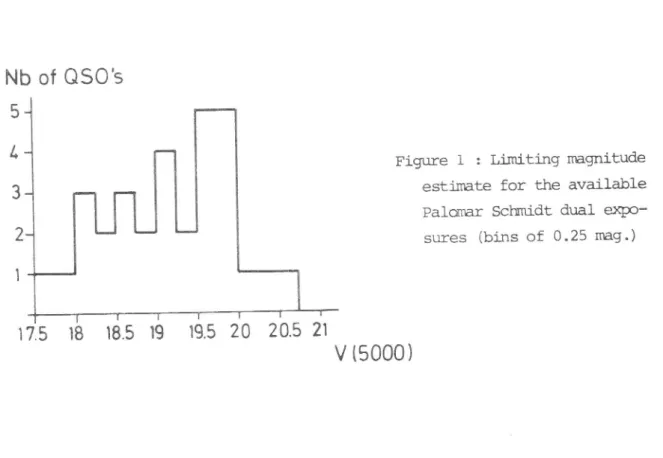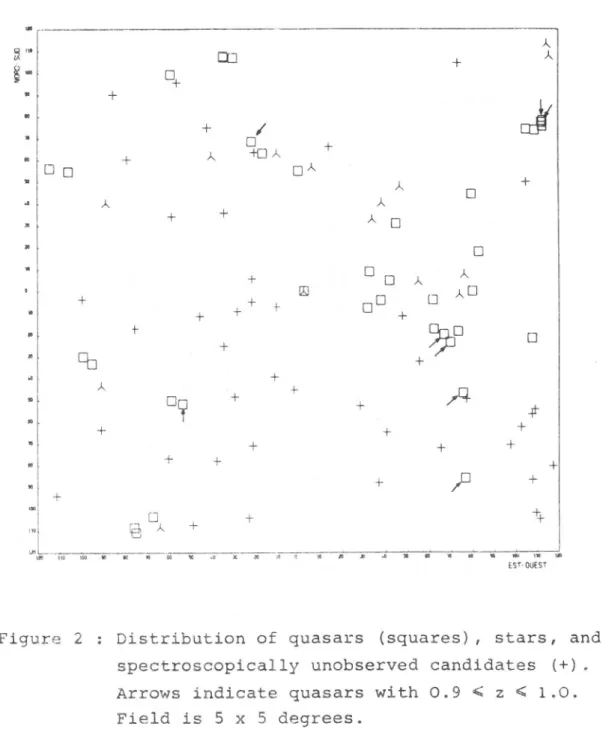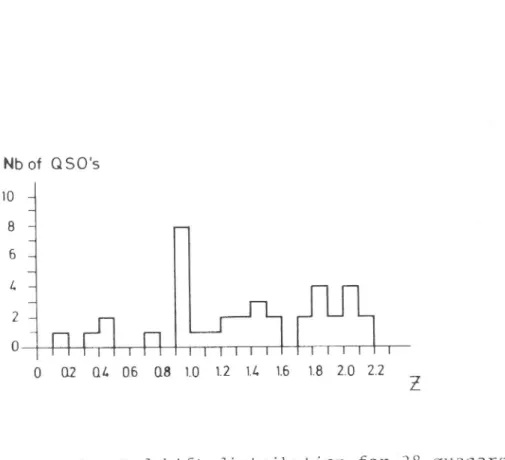(1) Institut d'Astrophysique, Université
de Liège;(2)
MountWilson
and Las Campanas Observatories,Carnegie
fnstj-tution of
Washington.*
Chercheur Qualifi-é au Fonds National- de 1a Recherche Scientifique (Belgium).Abstract:
PreLiminargyesults of a
searchfoy'QS)
candidatesin
a
25 square degz'eefieLd
around NGC 450are
prlesented.In order to further investigate the distribution'
spacedensity'
and
luminosity of
quasarsnear to
aswell as far
frombright
galaxies 'a large field area (1
25d"g.2)
centered, around. NGC 45O was searchedfor ultraviolet
excessobjects.
Onthe basis of a single
U,/B dualimage photographic
plate
obtainedwith the
Palomar48-inch
Schmidttelescope, a
homogeneous sampleof
96 QSO candidates was selected;57 were subsequently observed
spectroscopically with the following
instruments
:Palomar
5-m
HaIe telescopewith the
photoncounting or
2Ddouble sPectrograPhs;
-
E.S.O. 3.6-mtelescope with an
imagedissector
scanner;Las Campanas
2.2-m Irénée
Duponttelescope with a
"Shectograph"The 57 candidates
included 6 fairly bright
andvery blue objects
:I turned out to be a
QSO,the other 5 being stars.Of the
remaining5I,
37are quasars, 2
arepossible quasars,
IOare stars, I is
probably a star,
andI is a
galaxY.In addition to the
96first choice candidates, there exists
aset of about
2OOultraviolet
excessobjects that
needconfirmation
on the basis of a
second U/B exposure. Astatistical
analysis of
the quasarcandidates (cluster analysis, proximity, Iocation
onplate'
etc...)
is presently in
progress.Figure t plots the
numberof
quasarsin the field
centered around NGC 45O andin three adjacent fields versus their
continuumlevel at =
5OOOÂ, as
seenon
spectrophotometric scans: the
"Iimi-ting
V(5OOOÂ)
magnitude"is thus
foundto be
around L9.'75. No UBVphotometry has been performed
yet,
becauseof
bad weather conditionson La silra j'n september L982 '
-38-Nb
of
QSO'sFi$re I :
Ljmitingnaginitude estirnatefor
the availablePalcrnar Schfiddt dual oqn-sLrres (bjns
of
0.25 nrag.)175
l8 185 l9 r9.5 20v
(5000 )Figure 2 itlustrates
for the
96first choice
candidatesin
the 25 d,eg.2field., the location of the
confirmedquasars, of the stars,
andof the
remainingspectroscopically
unobservedcandidates.
Twogroups
are worth briefly describing
:a) the trio of
quasarsnear the S. Iimit of the plate
havethe
follo-wing redshifts : I.448,
2.LO4 and1.f69, the latter
two objectsbeing
separatedby only
27arcsec (the position
accuracyis of
order I
arcsecon the digitized blink
comparator usedfor
themeasurements).
A spectroscopic study at higher resolution is
plan-ned
at the
M.M.T.for these
twoobjects in collaboration with
P.Shaver and
G.
R.obertson,b) the quintet near the
W. edgecontains the very interesting
pairofquasarsQoroT-o25AB(z=o.96)towhichacontributionis
devoted (Surdej et aI,
1983,these
proceedings).! ! I t I uLl
/
o +o I t â t a ,1, !tr_
tJ nû 1 ^D tl {I LJ tr1/q
!nï
t.lE^'
anilr!0 tsl'outsrFlgure 2 : Distribution of
quasars
(squares), stars,
andspectroscopically
unobservedcandidates
(+) .Arrows
indicate
quasarswith
O.9Field is 5 x
5
degrees.Figure 3
showsthe redshift distribution of the
38quasars
in
the field of fLg.2 z a
markedconcentration
of
values
of z exists
between
O.9 and
1.O,
andis
seenfor I objects out of 38
(probabili-ty of
chance coinc.idence= 3xto-4).
Thecorresponding
objects
arelndicated
wlth
an arrow
in fj-g.2. Similar results
do
appearin
thesurrounding
fields
as
well.
Thequestion
of evolution
andof
quasarformatlon at a
cosmj-ctime of
O.9-40-Nb l0
I
6 of QSO's 1.2 1.4 1.6 r.8 2.0 2.2Figure 3 : Redshift distribution
for
38 quasarsÀ more complete
account of our results concerning the
surveyof the field briefly
described here will be published elsewhere
iit will contain quasar coordinates, representative spectra, line
iclentifications,
data on line strengths, redshifts,
etc..
'It should be
mentionedhere that fields
around NGC5334,
NGC 52O 'PKS 0054-0006, and
in the g=3hf.r
ô=-4Ooarea are also being
exami*ned
by the
same authorsPart of this research
wassupported by
NATOgrant no lff/81.
L 0 1.0 08 06 o/. 02
R. WEYMANN - Do you feel Èhat use of continuum magnitudes derived from objective prism â"t" (especially with IIIa-F plates) provide as much information as V-R pairs of direct plates ?
R.G. CLOI^IES - Continuum magnitudes are sensible because of the specifi-cation of Èhe selection effects. The errors seem to be quite sma1l
see Clowes and Savage I 983. COSMOS can be used in another mode to pro-vide V,R magnitudes if required.
D. I,IALSH - In the early stages of selecting QS0s from objective prism
plates, the effect of seeing was thought to be an important factor. Does your technique overcome this ?
R.G. CLOI^IES - The seeing is a païameter that is included in the trans-lation of the selection criteria into the physical selection effects. It is certainly an important factor and only plates with excellent seeing are \dorth processing. Eveïything can be quantified.
H. ARp - Some of the unobserved candidates in the field you showed are f ainter t.han 20 mag. If you made a cut of f brighter than 20 most of the candidates in the field would have been observed.
B. MARGON - One of the exciting implications of the log N/1og S curve that you display is that if this curve does not flatten aÈ B=21, Èhen faint QSQs cânnot be X-ray sources similar to brighter ones' as the observed intensity of the diffuse X-ray background would be exceeded.
The 1og N/1og S curve is a guite elegant and model-independent proof of this.
D. KOO - How does your Èota11y "quantitative" method eliminate stars' especially M dwarfs ?
R.G. CLOi^lES - The ADQ samples inevitably contain unwanted "junk" * exactly aligned overlaps, for example. There is no bias introduced by visualiy
""j""ting certain "junk". 0ther objects either remain or are omitted according to neTd selection limits.
H. MARSHALL - Measurements of the surface density of confirmed UV ex-cess quasars in the l3h. +36o f aint Braccesi region give 2013 per sq' deg.
"ittt B < 19.8. Extrapolating the steep N(< B) relation gives abôut 30 per sq. deg. at B=20. This result is consistent with those resulLs of Hawkins but not Swings.
J.I4r. SULENTIC - J. Lorre + myself have st.udied the problem of automa-ted quasar detection on CTI0 grism plates. I^le conclude that crowding of images is an almost insurmountable problem requiring visual clari-fication. Thus derived QS0 densities will be difficult Èo compare from
plare to plate especially when the fields are at different ga)-actic latitudes.
Question: Have any comparisons been made between visual and automaEed surveys of the same plate ?
-42-R.G. CLOWES - Overlapped spectra are 1ost, presumably at random. The use of second prism pf"t"s with the dispersion rotated by 90o minimises such losses. The effect is not serious at high galactic latitudes and
can be easily estimated from the image density. Comparisons have been made in rhe SGP fie1d. AQD finds ru 50-100 Z more plausible quasar
can-didates than the visual, search.
P.S. OSMER - The crowding problem is worse on grism plaÈes than ob* jective prism plat.es because of the zero order images in the former. D.L. JAUNCEY - When using N(M) staÈistics please use differential
counts, particularly when looking for any changes in N(M) with flux density, as the use of integral counts is statistically incorrect.
P.S. SSMER - How many of your candidate quasars have been confirmed by fol1ow up spectroscopy ?
R. G. CL0l,lES - None yet. An application f or AAT time is presently in the
allocation system. However many of the ne\"/ candidates are quite bright and strong-1ined, and include a BAL quasar. This fact illustrates my
point Ëhat the visual searches are not rea11y worth the effort.
D. WILLS - Since you require your candidates to vary by more than 0.3 fiâg, what effecÈ does this have on your number-magnitude counts ?
That is, at which epoch(s) does the object have to be < 2l mag ?.
M. HAI,IKINS - The magnitude at nininum is used. This preventsan artifi-cial Èurnover in the counts near the sample limit.
H. ARP - In discussing densities per sq. deg. to a limiting magnitude one must distinguish between broad band and continuum magnitudes. The
latter are about l/2 mag. fainter at 20th mag. The survey Swings discussed used continuum magnitudes.
H. MARSHALL - I^le use broad-band photometric blue magnitudes. No cor-rection for lines is included. The phorometric system \^7as calibrated with CCD observations.


